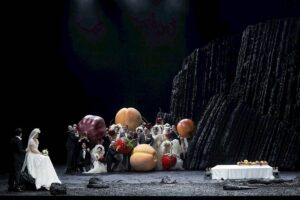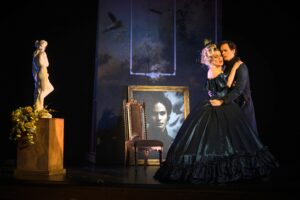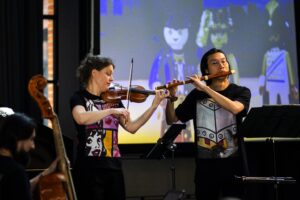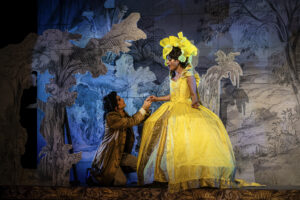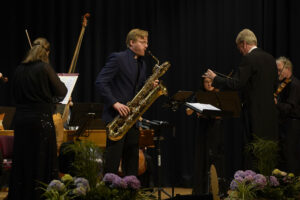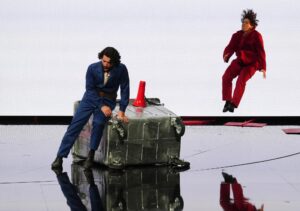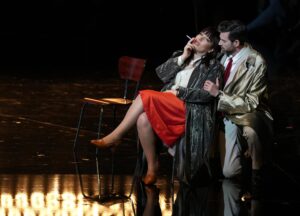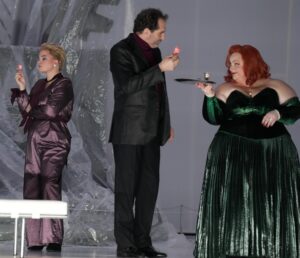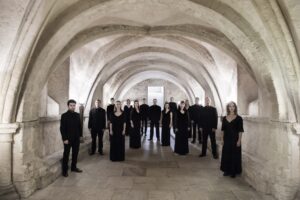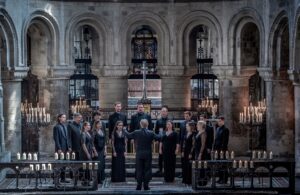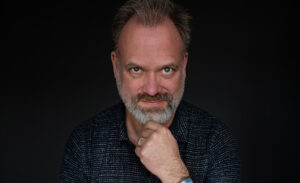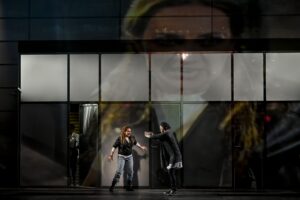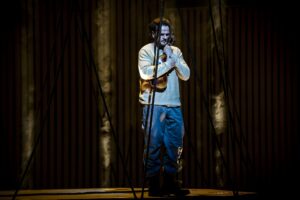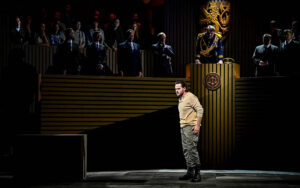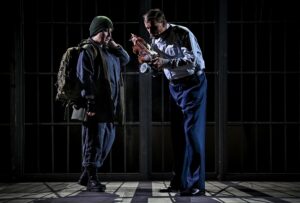Mistrz i Eurydyka
Na początku czerwca minęło dokładnie siedemdziesiąt lat od pierwszej próby wykonania Orfeusza na instrumentach historycznych: w ramach Wiener Festwochen, pod batutą Paula Hindemitha, oficjalnie z Wiener Symphoniker, w rzeczywistości – z udziałem muzyków tej orkiestry, którzy weszli w skład założonego rok wcześniej przez małżeństwo Harnoncourtów, wciąż jeszcze „bezimiennego” zespołu Concentus Musicus Wien. W długiej podróży arcydzieła Monteverdiego na sceny operowe już wtedy pojawiły się tropy szwajcarskie: wykonawcy korzystali z materiałów przygotowanych przez samego Hindemitha, który po wojnie objął profesurę na Uniwersytecie Zuryskim. Twórcą skromnej inscenizacji na estradzie Konzerthausu był Leopold Lindtberg, który w 1933 roku uciekł z Wiednia przed brunatną rewolucją i dotarł do Szwajcarii okrężną drogą przez Paryż, Warszawę i Tel Awiw.
Zapis dźwiękowy tamtego wydarzenia z 1954 roku opublikowano zaledwie kilkanaście lat temu, zbyt późno, by miłośnicy Orfeusza – nawet ci najstarsi, wychowani na słynnych nagraniach z Layosem Kozmą lub z Nigelem Rogersem – mogli potraktować je inaczej niż w kategoriach ciekawostki z epoki. Do historii przeszło jednak przedsięwzięcie Opernhaus Zürich, zainicjowane wkrótce po czterechsetnej rocznicy urodzin kompozytora i rozpoczęte inscenizacją La favola d’Orfeo, która okazała się prawdziwym przełomem w dziejach utworu. Po pierwsze, ze względu na koncepcję teatralną Jean-Pierre’a Ponnelle’a, która na długie lata wyznaczyła kanon inscenizacji oper barokowych. Po drugie, przez upamiętnienie tej produkcji w filmie telewizyjnym, wydanym później na płytach DVD, dzięki czemu zyskaliśmy dostęp do najstarszej chronologicznie wideorejestracji Orfeusza. Po trzecie i najważniejsze, ze względu na kierownictwo muzyczne Nikolausa Harnoncourta, który podjął decyzję, by dla potrzeb cyklu Monteverdiańskiego stworzyć osobny ansambl przy zespole zuryskiego teatru i skompletować obsady przede wszystkim z miejscowych artystów (w tytułowego śpiewaka z Tracji wcielił się wówczas Philippe Huttenlocher, bodaj pierwszy barytonowy odtwórca tej partii w dziejach wykonawstwa historycznego).
Scena zbiorowa z I aktu. Fot. Monika Rittershaus
Nie będzie zatem przesady w stwierdzeniu, że Orfeusz rozpoczął swój nowoczesny żywot sceniczny właśnie w Zurychu. I jakkolwiek dziś oceniamy inscenizacje Ponnelle’a – zdaniem malkontentów dawno przebrzmiałe, przez nie mniej licznych entuzjastów wciąż traktowane jako ważny punkt odniesienia – nie sposób uniknąć porównań między pamiętną inicjatywą z lat 70. a nowymi produkcjami oper Monteverdiego, które od czasu objęcia dyrekcji Opernhaus Zürich przez Andreasa Homokiego pojawiają się regularnie na tamtejszej scenie. Po Powrocie Ulissesa w reżyserii Willy’ego Deckera i Koronacji Poppei w ujęciu Calixta Bieito przyszedł czas na Orfeusza. Pod najnowszą premierą podpisał się Evgeny Titov, stosunkowo młody absolwent petersburskiej Akademii Sztuki Teatralnej, który po krótkiej karierze aktorskiej w Rosji podjął studia w Reinhardt Seminar w Wiedniu i od tego czasu reżyserował głównie spektakle dramatyczne. Jego doświadczenia w teatrze operowym ograniczają się do zaledwie kilku przedstawień, z których ubiegłoroczna Poppea w Opéra national du Rhin została zgodnie skrytykowana za niezgodność z koncepcją muzyczną Raphaëla Pichona.
Z zuryskim Orfeuszem poszło o tyle gorzej, że rozjechał się z koncepcją samego Monteverdiego. Titov osadził całość w jednolicie mrocznej scenerii (scenografia Chloe Lamford i Naomi Daboczi, kostiumy Annemarie Woods), czasem tylko rozświetlanej zimnym błyskiem stali, trupim światłem jarzeniówek i niebieskawą poświatą spowolnionych projekcji, przywodzących na myśl nieodparte skojarzenia ze snującą się w ciemnościach ektoplazmą. Orfeusz kopie grób już w Prologu, Eurydyka przed ślubem podniesie się z trumny, do której będzie później wracać na tyle często, by widzowie nabrali wątpliwości, czy aby na pewno mają do czynienia z istotą z krwi i kości. Frenetyczna energia pierwszego aktu i początku aktu drugiego – aż do słów „dopo il mal vie più felice”, po których nadchodzi Posłanka i Orfeusz przekonuje się w najokrutniejszy możliwy sposób, że nie należy wywoływać wilka z lasu – nie znajduje żadnego odzwierciedlenia na scenie. Radosne pląsy pasterzy przybierają postać groteskowych obrzędów przedślubnych – w jałowej czerni bazaltowych skał, z wyblakłymi kwiatami w męskich butonierkach i wielkimi sztucznymi owocami w miejsce bujności łąk Tracji. Jaśniej – paradoksalnie – robi się dopiero po zejściu do Tartaru. Śmierć jednak czai się wszędzie. Orfeusz, straciwszy po raz kolejny Eurydykę, być może od początku martwą, trafia znów w tę samą scenerię z białą trumną i rozkopanym grobem. Zawezwany przez Apolla do nieba, ociąga się chwilę zbyt długo. W ciemnościach wygaszonej sceny rozlega się huk wystrzału.
Krystian Adam (Orfeusz). Fot. Monika Rittershaus
W kuluarach toczyły się dyskusje, czy reżyser chciał zmienić Monteverdiańską baśń o Orfeuszu w koszmarny sen samobójcy, równie koszmarną wędrówkę w głąb emocji towarzyszących utracie, czy też uniwersalną przypowieść o zgubnych konsekwencjach nadmiaru uczuć. Ośmielę się wysunąć jeszcze inną hipotezę: że Titov podjął nieudaną, choć momentami atrakcyjną wizualnie próbę opowiedzenia historii Orfeusza przez pryzmat Mistrza i Małgorzaty Bułhakowa. Stąd dziwne podobieństwo scen w I akcie do wielkiego balu u szatana. Stąd wszechobecny mrok inscenizacji, bo Mistrz nie zasłużył na światłość, tylko na spokój. Stąd podejrzanie mefistofeliczny wygląd Apolla w finale. Dlatego sugestia, że umrzeć muszą oboje – Orfeusz i Eurydyka – żeby odejść do innego świata. Wszystko pięknie, tylko bez związku z librettem Striggia i nieraz w rażącej sprzeczności z muzyką.
Ta zaś wybrzmiała w Zurychu z dostatecznym blaskiem, by wynagrodzić wszelkie niedostatki inscenizacji Titova. W starannie dobranej obsadzie odznaczyli się zwłaszcza panowie: obdarzony szlachetnym i doskonale podpartym basem Mirco Palazzi w podwójnej roli Charona i Plutona; doświadczony brytyjski tenor Mark Milhofer w partii Apolla, dysponujący głosem jasnym i wyrównanym w rejestrach; a także ujmujący giętkością i swobodą frazy Massimo Altieri jako Pierwszy Pasterz. Wśród głosów żeńskich szczególną uwagę zwróciła Simone McIntosh, której krągły i bogaty w alikwoty mezzosopran w równym stopniu przekonał słuchaczy w partii Nadziei, jak i w skrajnie odmiennej pod względem wyrazowym roli Prozerpiny. Odrobinę rozczarowała Miriam Kutrowatz, realizująca partię Eurydyki jakby z dystansu, przez co nie zdołała ukazać w pełni walorów swego srebrzystego sopranu. José Maria Lo Monaco (Muzyka/Posłanka/Echo) miała czasem kłopot z powściągnięciem zbyt szerokiego wibrata, poza tym jednak jej interpretacje wyróżniały się sporą muzykalnością i wyczuciem stylu.
Mark Milhofer (Apollo), Miriam Kutrowatz (Eurydyka) i Krystian Adam. Fot. Monika Rittershaus
Rewelacją zuryskiego przedstawienia okazał się jednak Krystian Adam w partii Orfeusza. Jego żarliwy tenor z każdym kolejnym sezonem nabiera coraz piękniejszego barytonowego odcienia w dolnym odcinku skali, nie tracąc zarazem ani czystości wysokich dźwięków, ani zdolności dokonywania płynnych przejść między rejestrami. Co jednak najistotniejsze, śpiewak imponuje znakomitą włoską dykcją, zrozumieniem tekstu i swobodą techniczną, dzięki której niezmierzone bogactwo Monteverdiańskich ornamenti i abbellimenti traci wszelkie znamiona pustego popisu i służy wyłącznie temu, czemu ma służyć, czyli podkreśleniu zawartych w muzyce afektów. Nieobecność L’Orfeo w repertuarach polskich teatrów operowych jest dla mnie coraz większą zagadką: z pewnością nie możemy już się tłumaczyć brakiem godnego wykonawcy partii tytułowej.
Pięknego obrazu całości dopełnił znakomicie przygotowany chór Zürcher Sing-Akademie oraz orkiestra La Scintilla, od ponad dwudziestu lat kontynuująca tradycję zapoczątkowaną w Opernhaus Zürich przez Harnoncourta. Całość poprowadził Ottavio Dantone, korzystając już po raz drugi z nowej edycji Bernarda Ticciego, przygotowanej z myślą o wcześniejszej produkcji w Lozannie, której premiera odbyła się w roku 2016. Tym razem zyskała wrażliwszych i bardziej kompetentnych odtwórców, co dało o sobie znać już w słynnej Toccacie, wzbogaconej jasnym, miękkim dźwiękiem barokowych cynków. Szkoda, że tej muzycznej energii nie dał się porwać reżyser. Nie tracę jednak nadziei, że kiedyś spełnią się słowa Bułhakowowskiej Małgorzaty i wszystko będzie tak, jak być powinno.

